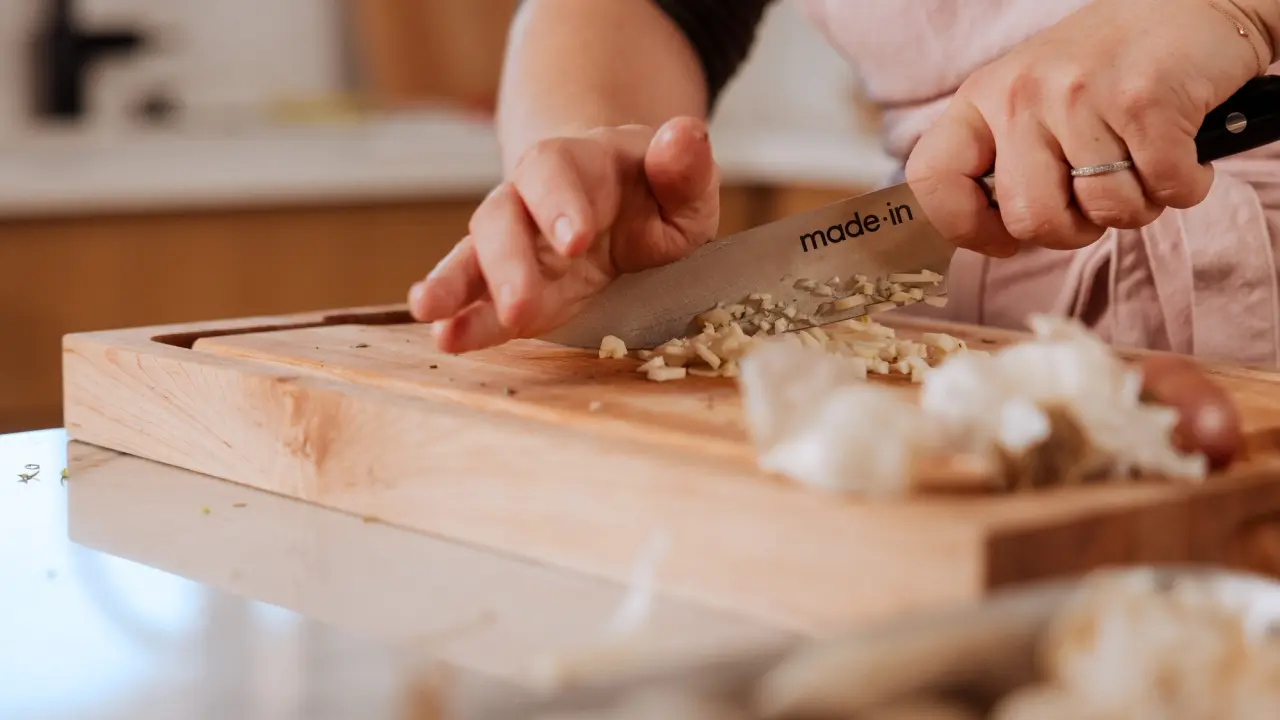Sturdy and functional and with the rustic look of a cast iron skillet or wood-handled knife, butcher blocks are a sturdy, dependable landing pad for any kind of knife work—butchering included. And while a plastic cutting board or thinner wooden cutting board will eventually need to be replaced, a high-quality butcher block should last you a lifetime.
Of course, like many investment-worthy cookware items, butcher blocks need a little bit of upkeep to maintain their luster. But if you’re prepared to put in the work, you’ll have a piece that more than deserves the extra counter space. Here’s how.
What Is a Butcher Block?

In the past, the term “butcher block” described a heavy wooden board made from rectangular blocks of wood joined together to form a checkerboard pattern, and which feature a visible cross-section of wood fibers. This is called end-grain construction, which we’ll go over in detail later on. These days, however, a butcher block is used to describe almost any thick wooden cutting board, and you’ll even see kitchens fitted out with butcher block-style countertops.
No matter what you decide to call them, however, butcher blocks—especially well-made ones—make for a fantastically durable and versatile cutting surface. Since they tend to be fairly heavy, these boards remain stable on your countertop, so you can carve, slice, and chop without worrying about your board slipping or wobbling.
Understanding Butcher Block Construction
Butcher blocks originally referred to wooden boards made from end-grain wood, whereas a wooden cutting board was made with edge-grain. This is because end-grain wood, which is made by cutting a tree trunk cross-wise, tends to better absorb the blows of a knife than edge-grain wood, which is cut length-wise.
You don’t have to go for an end-grain board, however: nowadays, there are plenty of high-quality edge-grain butcher boards on the market—including ours— which can be just as durable and long-lasting as end-grain.
As far as the actual type of wood your butcher block is made from, we highly recommend softer woods like maple. These are gentler on your knife than bamboo, yet harder and more resilient than something like cherry wood.
How to Clean a Butcher Block
Caring for your butcher block looks pretty much the same as caring for your standard wooden cutting board—make sure to clean it after each use with mild soap, warm water, and a soft brush or sponge, and never put it in the dishwasher.
This goes for any wooden cutting board (or any wooden tool, for that matter, including wood handled knives), as a board that’s been saturated with water will expand unevenly as it dries, which can cause cracks and other damage. Whenever you wash your butcher block, make sure to dry it as thoroughly as possible by hand, then lean it against the wall or other upright surface to finish drying.
Regular Maintenance and Hygiene Practices

Luckily, most of the work required to maintain your butcher block comes down to oiling and conditioning.
Regularly Oil
Because wood dries out easily, you’ll need to regularly apply a food-safe mineral oil or neutral-flavored oil of your choice, like our Wood Conditioner, to keep it from cracking.
To do this, simply apply a small amount of oil to your block, then use a paper towel or dish towel to rub it all over the surface. You can also apply a conditioner, such as beeswax or a special board wax, for an extra layer of protection against stains.
Prevent Cross-Contamination
You’re probably also wondering how—if wood is naturally porous—to prevent cross-contamination when using your board to prep raw meat and fish. One way to do this is by purchasing a block made from antimicrobial wood, like maple, as these wood types help to trap and kill bacteria. You can also play it safe by using a plastic board, or one that can be run through the dishwasher, for raw proteins.
Be Aware of Staining
For removing stains, we find that scrubbing your board with a paste of hot water and baking soda is an excellent—and inexpensive—fix. Swap the water out for lemon juice to get rid of strong odors, and feel free to substitute coarse salt for baking soda for either method.
How to Revive and Restore a Worn Butcher Block

A pampered butcher block will age like a fine wine, developing richness and character over the years. It will also—inevitably—start to look a little bit worn, especially if it’s been well-loved. Luckily, wood is easier to repair than other materials. If your board is starting to look dull or dry, it’s probably just in need of a little oiling or conditioning. This will help to restore the original luster and shine.
Ready to Cook?
Your cutting board is a hardworking and dependable sous chef, and you should make sure to show it some love in return. Even with the extra maintenance, a piece that inevitably ends up living on your countertops is well-worth the extra effort.
For this reason, a butcher block should be more than functional—it should be beautiful as well. Our newly designed edge-grain maple wood Butcher Block fits the bill, featuring a dual-sided design—one flat side for serving or charcuterie, and a grooved side for catching runoff from ingredients. Paired with our brand new Wood Conditioner, you have everything you need to keep this Butcher Block lustrous for years—and many meals—to come.























